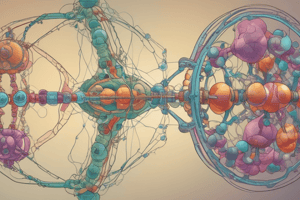Podcast
Questions and Answers
What is the primary function of anabolism in metabolism?
What is the primary function of anabolism in metabolism?
- The removal of electrons from molecules
- The generation of ATP through oxidative phosphorylation
- The synthesis of complex molecules from simpler ones (correct)
- The breakdown of glucose into energy
Which process is characterized by the breakdown of glucose during cellular respiration?
Which process is characterized by the breakdown of glucose during cellular respiration?
- Photosynthesis
- Oxidation
- Anabolism
- Catabolism (correct)
Which of the following describes glycolysis?
Which of the following describes glycolysis?
- It produces two pyruvate molecules from one glucose molecule (correct)
- It directly synthesizes ATP without intermediates
- It requires oxygen for glucose degradation
- It occurs in mitochondria and generates FADH2
What is the function of enzymes in metabolic processes?
What is the function of enzymes in metabolic processes?
Which statement about aerobic respiration is true?
Which statement about aerobic respiration is true?
What are nucleotides composed of?
What are nucleotides composed of?
Which molecule is primarily responsible for energy transport in cells?
Which molecule is primarily responsible for energy transport in cells?
What happens during the electron transport chain?
What happens during the electron transport chain?
How many ATP molecules are produced in glycolysis?
How many ATP molecules are produced in glycolysis?
Which of the following processes occurs in the absence of oxygen?
Which of the following processes occurs in the absence of oxygen?
Study Notes
Anabolism and Catabolism
- Anabolism is the process of synthesizing complex molecules from simpler ones, requiring energy.
- Catabolism breaks down complex molecules into simpler ones, releasing energy.
- Metabolism is the complete set of chemical reactions within cells, incorporating both anabolic and catabolic pathways.
Oxidation
- Oxidation removes electrons from molecules, often releasing energy.
Nucleotides
- The building blocks of nucleic acids (DNA and RNA).
- Nucleotides contain a nitrogenous base, a sugar, and one or more phosphate groups.
Codon and Triplet
- Codon is a sequence of three nucleotides that represent a unit of genetic code within DNA or RNA.
- Triplet is another name for a codon, emphasizing its three-nucleotide structure.
Metabolic Pathways
- Metabolic pathways are a series of interconnected reactions, organized into steps.
- Glycolysis, the first step in cellular respiration, occurs in the cytoplasm; glucose is broken down into two pyruvate molecules.
- Citric Acid Cycle (Krebs Cycle) occurs in the mitochondria; acetyl-CoA is processed into CO2, generating NADH and FADH2 for the electron transport chain.
- Electron Transport Chain located in the inner mitochondrial membrane uses electrons from NADH and FADH2 to create a proton gradient for ATP synthesis via oxidative phosphorylation.
Enzymatic Function
- Enzymes are biological catalysts that accelerate chemical reactions without being consumed.
- Enzymes bind to substrates at their active sites, forming an enzyme-substrate complex.
- This complex reduces the activation energy required for reactions.
Cellular Respiration
- Aerobic Respiration utilizes oxygen to convert glucose into carbon dioxide and water, producing a large amount of ATP.
- Anaerobic Respiration occurs without oxygen, resulting in the formation of lactate or ethanol. It produces a smaller amount of ATP compared to aerobic respiration.
Energy Molecules: ATP and ADP
- ATP (Adenosine Triphosphate) is the primary energy carrier in cells.
- ADP (Adenosine Diphosphate) is formed when ATP loses a phosphate group. ADP can be converted back to ATP through phosphorylation.
Genetic Material: DNA and RNA
- DNA (Deoxyribonucleic Acid) stores genetic information and participates in the synthesis of proteins.
- RNA (Ribonucleic Acid) regulates protein synthesis with different types, each having a specific function:
- mRNA (Messenger RNA) carries genetic information from DNA to the ribosome for protein synthesis.
- tRNA (Transfer RNA) brings amino acids to the ribosomes for translation.
- rRNA (Ribosomal RNA) forms the ribosome's core and catalyzes protein synthesis.
Complementary Base Pairing
- DNA: Adenine pairs with Thymine (A-T), and Cytosine pairs with Guanine (C-G).
- RNA: Adenine pairs with Uracil (A-U), and Cytosine pairs with Guanine (C-G).
Studying That Suits You
Use AI to generate personalized quizzes and flashcards to suit your learning preferences.
Description
Test your knowledge on the key concepts of metabolism, including anabolism, catabolism, and metabolic pathways. Explore the structures and functions of nucleotides and the significance of codons in genetic coding. This quiz will challenge your understanding of these essential biochemistry topics.




